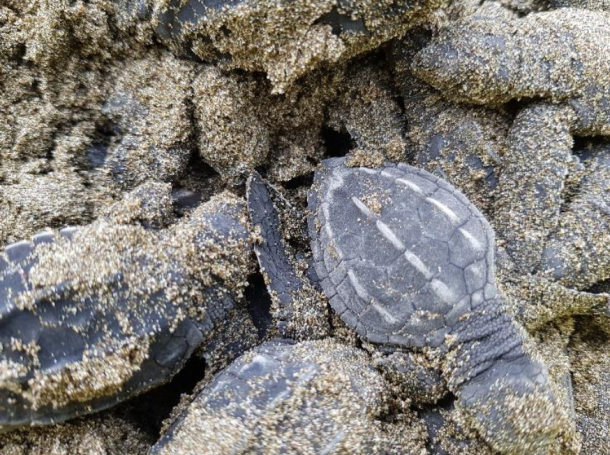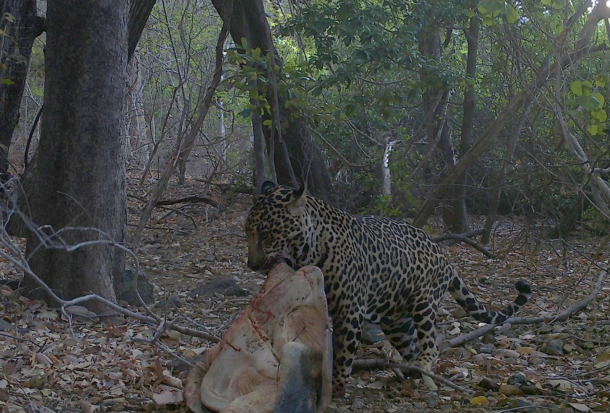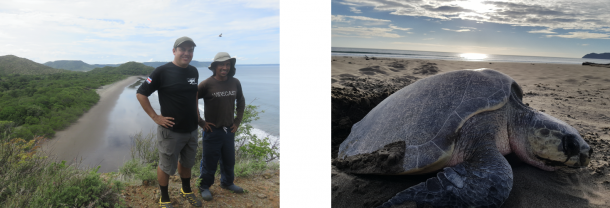GDFCF supports the work of Costa Rican scientists and their research on iconic species that call ACG home, such as several species of threatened sea turtles, as well as the jaguars that prey upon them.
Sea Turtles and Jaguars

Olive Ridley hatchlings (photo by Luis Fonseca).
The coastlines of ACG support some of the most globally important nesting beaches in the world for Olive Ridley sea turtles (Lepidochelys olivacea). Its pristine and undisturbed beaches are also home to nesting Green, Hawksbill, and Leatherback sea turtles. Olive Ridley sea turtles are known for their mass synchronized nesting events, called arribadas, when thousands of turtles come nightly to the beaches of ACG. Turtle biologist Luis Fonseca López has been studying the sea turtles of ACG for more than a decade. His sea turtle monitoring project is integral to understanding population trends over time and in designing management and conservation actions that promote the recovery of sea turtle populations in this part of Costa Rica. Fonseca has also expanded his research focus to cover the prey/predator phenomenon between nesting sea turtles and ACG’s jaguar (Panthera onca) population. While his research shows that the number of turtles eaten by jaguars has little effect on the overall population of Olive Ridleys, the turtles are an important source of food for animals of higher trophic level, such as jaguars, crocodiles, mountain lions and birds. Along with supporting Fonseca’s research, GDFCF has contributed to refurbishing Estación Nancite, one of ACG’s most remote research stations, where much of Fonseca’s work is based. You can access Fonseca's published research below:
- Luis G. Fonseca, Wilbert N. Villachica, Eduardo Rangel, Eric Palola, Monique Gilbert, Roldán A. Valverde. Reassessment of the Olive Ridley Sea Turtle Lepidochelys olivacea Nesting Population at Nancite Beach, Costa Rica. Marine Ecology. 2023.
- Fonseca, L. G., Villachica, W. N., Rangel, E., Aguilar, J. P., Palola, E., Gilbert, M., Quirós, W. Plotkin, P., Castro, M., Zeledón, R., Rodríguez, J. O., Sánchez, A., Fernández, R., Santoro, C. M., Chaves, B., Spínola, R. M. & R. A. Valverde. Monitoreo de los jaguares predadores de tortugas marinas en las playas de Nancite y Naranjo (periodo 2005 -2021), Área de Conservación Guanacaste. Fundación Grupo de Amigos Naturalistas (FUNGUANA). 2022.
- Luis G. Fonseca, Stephanny Arroyo-Arce, Ian Thomson, Wilbert N. Villachica, Eduardo Rangel, Roldán A. Valverde, Pamela T. Plotkin, Wagner Quirós-Pereira. Impacts of Jaguar Predation on Nesting Sea Turtles at Nancite Beach, Santa Rosa National Park, Costa Rica. Herpetological Conservation and Biology. 16 December 2020.
- P. Santidrián Tomillo, L.G. Fonseca, M. Ward, N. Tankersley, N.J. Robinson, C.M. Orrego, F.V. Paladino, V.S. Saba. The Impacts of Extreme El Niño Events on Sea Turtle Nesting Populations. Climatic Change. 15 January 2020.
- Luis G. Fonseca, Pilar Santidrián Tomillo, Wilbert N. Villachica, Wagner M. Quirós, Marta Pesquero, Maike Heidemeyer, Frank Joyce, Pamela T. Plotkin, Jeffrey A. Seminoff, Eduardo R. Matarrita, Roldán A. Valverde. Discovery of a Major East Pacific Green Turtle (Chelonia mydas) Nesting Population in Northwest Costa Rica. Chelonian Conservation and Biology. 2018.
- Luis G. Fonseca, Stephanny Arroyo-Arce, Ian Thomson, Wilbert N. Villachica, Roldán A. Valverde. Records of Pumas Scavenging at Jaguar Kills in Santa Rosa National Park, Costa Rica. CATnews. Spring 2018.
- Pilar Santidrián-Tomillo, Nathan J. Robinson, Luis G. Fonseca, Wagner Quirós-Pereira, Randall Arauz, Madeleine Beange, Rotney Piedra, Elizabeth Vélez, Frank V. Paladino, James R. Spotila, Bryan P. Wallace. Secondary Nesting Beaches for Leatherback Turtles on the Pacific Coast of Costa Rica. Latin American Journal of Aquatic Research. 2017.
- Luis G. Fonseca, Stephanny Arroyo-Arce, Ian Thomson, Wilbert N. Villachica, Roldán A. Valverde. New Records of Jaguar Predation on Sea Turtles, Pacific Coast, Costa Rica. CATnews. Autumn 2017.
- Sergio Escobar-Lasso, Luis G. Fonseca, Wilbert N. Villachica, Hansel Herrera, Roldán A. Valverde, Wagner Quirós-Pereira, Marta Pesquero, Pamela T. Plotkin. First Field Observation of the Predation by Jaguar (Pantera onca) on Olive Ridley Sea Turtle (Lepidochelys olivacea) at Nancite Beach, Santa Rosa National Park, Costa Rica. Mammology Notes. 2016.
- Sergio Escobar-Lasso, Margarita Gil-Fernández, Hansel Herrera, Luis G. Fonseca, Eduardo Carrillo-Jiménez, Joel Sáenz, Grace Wong. Scavenging on Sea Turtle Carcasses by Multiple Jaguars in Northwestern Costa Rica. Therya. 2016.
- Sergio Escobar-Lasso, Luis G. Fonseca, Margarita Gil-Fernández, Wilbert N. Villachica, Stephanny Arroyo-Arce, Ian Thomson, and Joel Sánez. First Record of Consumption of Olive Ridley Sea Turtle by a Cougar. CATnews. Autumn 2016.
- Luis G. Fonseca, Grettel A. Murillo, Lenín Guadamúz, Romeo M. Spínola, Roldán A. Valverde. Downward But Stable Trend in the Abundance of Arribada Olive Ridley Sea Turtles (Lepidochelys olivacea) at Nancite Beach, Costa Rica (1971-2007). Chelonian Conservation and Biology. 2009.

An Olive Ridley turtle will be this jaguar's next meal (photo by Luis Fonseca).

Photo, left: Turtle biologist Luis Fonseca López (left) and his assistant, Eduardo Rangell (right), on a promontory overlooking Nancite Beach. Photo, right: An Olive Ridley lays her eggs on an ACG beach (photos by Eric Palola and Luis Fonseca)